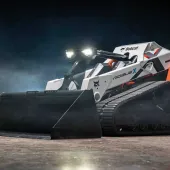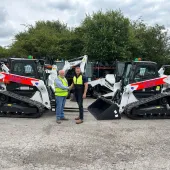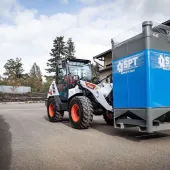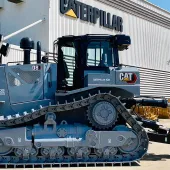‘Port edition’ Bobcat skid-steers for ZHD Stevedores

Specially modified loaders provide flexible solution for unloading bulk materials from ships
FOR more than 50 years, stevedoring company ZHD Stevedores, based in Dordrecht, in the Netherlands, have been using Bobcat skid-steer loaders to clear the holds of ships and to move material around so that the grabs on the large dockside unloading cranes are kept busy.
This way of working was introduced in order to unload or load ships as quickly as possible so that they can sail again, as idle time costs money in shipping. Any part of a ship’s load that remains out of reach of the grabs on the cranes is dealt with by the Bobcat loaders using hydraulic sweeper and bucket attachments.
Due to the environment in which these machines are required operate, the loaders used for this task, including two new Bobcat S770 models recently purchased by ZHD, have to undergo many modifications before they are delivered to the company.
The modification work is carried out by Bobcat’s Dutch importers, Inter-Techno, who describe it as creating a ‘port edition’ of the skid-steer loader. All the modifications are made at Inter-Techno’s workshops in Apeldoorn, after which the machines are delivered ready for use in the corporate colours of ZHD.
ZHD Stevedores have been using this method of discharging ships since the 1960s and say it has proved to be the most flexible solution, as the wide variety of bulk material cargoes involved – including sand, gravel, coal and slag – make it impossible to use other methods such as conveyor belts or suction systems.
‘The modifications on the machines include the treatment of plugs and cable harnesses with a special moisture-resistant coating, as the moist and dusty environment they work in is not good for the electronics on board,’ explained Jan Elferink, material management manager at ZHD Stevedores.
‘The adjustments to the cabs are also important,’ he continued. ‘Drivers used to work in an open cab with a cage construction, but the requirements for working conditions and safety have become increasingly strict. To protect the driver against dust, overpressure cabs are used to keep the dust out. Air that is blown into the cab goes through a P1 and P3 filter that captures very fine particles, so the drivers no longer need to wear masks.’
The standard cab on Bobcat skid-steer loaders is both ROPS and FOPS certified, but for even greater driver protection, the glass in the door of the machines is replaced by Bobcat-Lexan, a strong plastic material that is very difficult to break or damage. In addition, to give the driver even better all-round visibility, a special ZHD rear-view camera is mounted on the rear hood.
A number of modifications are also made to the exterior of the Bobcat loaders. The machines are sprayed in the blue and yellow house colours of ZHD and four additional tie-down points are added, two on either side of the upper structure, to which hoisting straps can be attached, thereby allowing the Bobcats to be lifted in and out of ship holds.
Also, to make them more robust, the skid-steer loaders are weighted at the front, steel plates are welded to the lifting arms to protect the hydraulic cylinders, and a heavy steel bumper is welded to the rear to protect the engine from collisions with the walls of the hold. These modifications add an extra 600kg of weight to each loader, but result in even better stability and more load capacity.
Finally, the engines have to comply with special requirements because the Bobcat loaders work in almost completely enclosed spaces. Because of stricter requirements with regard to working conditions and emissions legislation, ZHD’s older models have been equipped with soot filters or use AdBlue mixed with the diesel.
‘The new generation of Bobcat skid-steer loaders has Stage V engines, but in the long run, electric Bobcat machines might be a very good alternative,’ commented Mr Elferink.
Currently, ZHD Stevedores use 16 Bobcat machines, including the two new S770 skid-steers acquired at the end of January 2020. Regular maintenance and repairs are carried out in house, although the company has also added extra Protection Plus warranty for the new machines, which offers an extended warranty period of three years.









